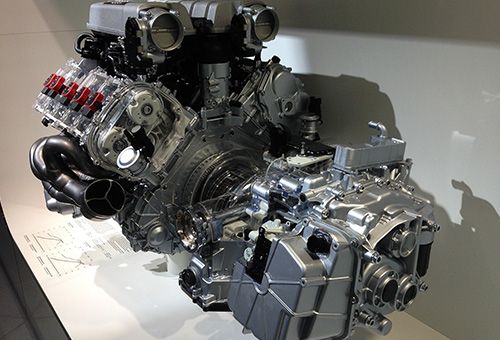The Ultimate Overview to Purchasing Used Engines for Sale with Self-confidence
The Ultimate Overview to Purchasing Used Engines for Sale with Self-confidence
Blog Article
Essential Factors To Consider for Guaranteeing Quality and Longevity being used Engines
When thinking about the purchase of a used engine, guaranteeing its high quality and long life requires a multifaceted approach. Maintenance background is a critical aspect, as it offers insight right into the engine's previous treatment and possible future integrity. Beyond paperwork, a detailed inspection of physical components-- such as belts, hoses, and seals-- can expose covert problems. Performance screening is additionally important, supplying a snapshot of the engine's operational effectiveness. However, comprehending the subtleties of these assessments and their ramifications can be intricate. What are the key techniques that can be used to navigate this elaborate examination process successfully?
Engine Background Assessment
In the world of used engines, an extensive engine background evaluation is extremely important to making certain top quality and dependability. Recognizing an engine's past can give critical understandings into its performance capacities and prospective future longevity. A thorough history testimonial incorporates several key facets that play a considerable function in assessing an engine's condition. Maintenance records are essential. Normal upkeep, including oil adjustments, filter replacements, and arranged tune-ups, indicate that the engine has been well-cared-for, decreasing the probability of unanticipated failures.
Engines that have undergone substantial repair services might have underlying concerns that can resurface. Analyzing the engine's gas mileage can serve as an indication of wear and tear. An engine used largely for long-distance freeway driving might be in much better problem than one subjected to frequent stop-and-go city website traffic.
Essentially, an exhaustive examination right into an engine's history is vital for making informed investing in choices. used engines for sale.
Comprehensive Evaluation Guide
While understanding an engine's history gives beneficial context, a thorough evaluation is the following action to guarantee its present condition straightens with historical data. The assessment must start with an aesthetic analysis, looking for indicators of leakages, rust, and unusual wear. Inspect the exterior for oil spots or coolant marks, which may suggest underlying issues.
Next, evaluate the engine's installing system for any type of loosened bolts or abnormalities that might impact efficiency. Pay close interest to the problem of belts and hose pipes, as these components are important for optimum engine functionality. Analyze for splits, fraying, or any type of indications of deterioration.

Recognizing Use and Tear
Recognizing signs of deterioration is vital for examining a made use of engine's durability and dependability. It entails a thorough assessment of various engine parts to identify their current state and possible future performance. Typical indicators consist of noticeable deterioration, which can impact steel components and jeopardize architectural honesty. Corrosion on or around the engine block, cylinder heads, and exhaust manifolds is especially worrying.
Another crucial element is evaluating the engine's seals and gaskets. These components are vital for preserving correct stress and preventing fluid leaks. Evidence of oil leaks or used gaskets commonly suggests damage, possibly resulting in much more extreme issues if not resolved quickly. Furthermore, unusual sounds during engine operation, such as knocking or ticking noises, might suggest inner damages or excessive endure relocating parts like pistons or bearings.
The problem of belts and hoses is just as crucial, as they play a vital function in the engine's overall feature. Cracked or torn belts and breakable hoses are indications old that might lead to engine failure if neglected. Examining the oil condition and filter can give understandings into previous maintenance practices, as filthy oil or clogged up filters suggest neglect and accelerated wear.
Performance Screening Fundamentals
Examining the wear and tear of engine parts sets the phase for a comprehensive analysis via efficiency testing. Performance screening works as a critical measure in determining the operational stability of a used engine. By simulating real-world problems, it assesses the engine's ability to deliver power efficiently and dependably. Key metrics consist of horsepower, torque, fuel effectiveness, and exhausts levels. This information gives beneficial insights into the engine's current performance and assists recognize potential issues that might not be right away noticeable.
Using dynamometers is an usual technique in efficiency screening. These devices determine the engine's result across various conditions, offering an in-depth account of its capability. Furthermore, on-road testing matches dynamometer analyses by observing engine behavior under regular driving situations, ensuring it fulfills the required standards for both safety and effectiveness.
These devices evaluate engine management systems, determining faults in electronic elements that can impact performance. Comprehensive screening not just verifies the engine's functional condition yet additionally help in forecasting future maintenance demands.
Upkeep and Care Tips
Proper maintenance and treatment are crucial to prolonging the lifespan check my blog of an utilized engine and guaranteeing its constant performance. Regular oil changes are paramount; making use of the supplier's advised oil kind and grade can protect against too much deterioration. Furthermore, oil filters should be replaced simultaneously to maintain optimum lubrication and sanitation within the engine.
Monitoring liquid levels, consisting of coolant, transmission liquid, and brake fluid, is necessary. Making certain these liquids are at ideal degrees assists avoid getting too hot and various other mechanical problems. Evaluating belts and tubes for indications of wear, such as cracks or fraying, can avoid prospective failures that might lead to pricey repair services.
Routine examination of the air filter is likewise necessary, as a tidy filter makes sure effective air movement and burning, thus optimizing engine performance. Ignition system ought to be examined and replaced when required to maintain efficient this post gas combustion and protect against engine misfires.
Last but not least, regular analysis checks making use of professional devices can recognize possible concerns before they come to be considerable troubles. By sticking to these maintenance and care suggestions, used engine owners can ensure their engines stay reputable, efficient, and with the ability of doing well over an extensive period.
Final Thought

Report this page